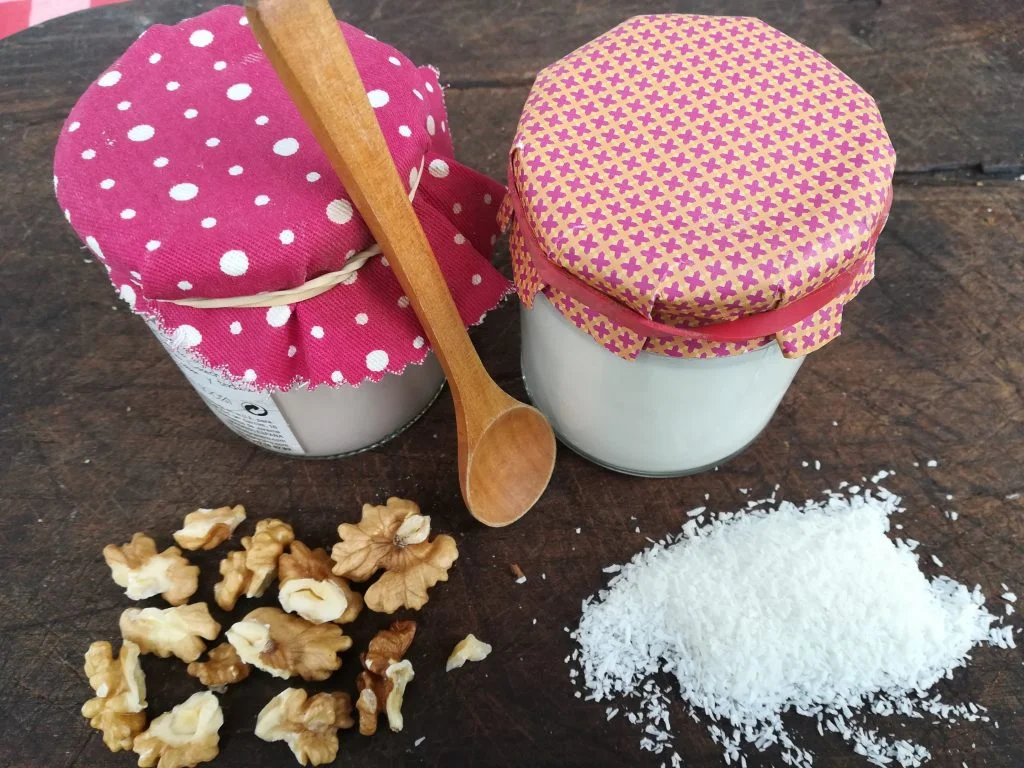
A few years ago,we started experimenting with how to make vegan yogurt with plant milks and, since then, we have been improving our recipes through trial and error. In this article you will find the latest discoveries that will make it easier to make vegan yogurt at home.
If you remember, we got to make our first vegan soya yogurt, an actual probiotic one which was just as nutritious as its dairy counterparts. And when we say “actual”, it’s because there’s no lack of recipes for yogurts which look like the real deal, yet they’ve not gone through the actual fermentation process necessary for them to be qualified as such. Yes, they might be creamy and delicious, but they aren’t quite as nourishing as the probiotic ones.
As you can see, the vegan soy yogurt was our first achievement. Concentrated soya milk curdles easily, but honestly, for me, the taste is not very appealing. So I would like to find the ideal vegan yogurt that not only has probiotic properties, but also a pleasant taste. So I decided to keep looking.
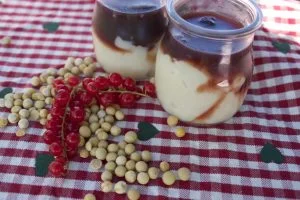 Could we make creamy and thick vegan yogurts using other plant milks? Maybe a coconut or a walnut version? What if I go for sunflower seeds, as they’re much cheaper?
Could we make creamy and thick vegan yogurts using other plant milks? Maybe a coconut or a walnut version? What if I go for sunflower seeds, as they’re much cheaper?
Driven by my innate curiosity and by the many queries and suggestions I have received on the blog following this first vegan yogurt recipe with soya milk, I have carried out many experiments to make yoghurt with almond milk, coconut milk, pip milk, nut milk, cashew milk…. This task wasn’t an easy one, I’ll give you that. There was a lot of research involved, as well as a ton of experimenting.
I have also tried making vegan yogurt in a yogurt maker by replacing the soy yogurt (from the store) that we use as a starter, with probiotic sachets or capsules to be able to compare the two versions and have more options.
In this article you will find all the tips I have compiled so far to make other varieties of vegan yogurt with probiotics in a yogurt maker, beyond the classic soy yogurt.
I have also explored the option of making vegan yogurt with rejuvelac or enzymatic water. If you are interested in trying to make yogurt with this method, using enzymatic water or rejuvelac as a starter, I recommend the article Vegan cashew yoghurt with rejuvelac, where you will find extensive information including some video-tutorials.
Basic advices on how to make vegan yogurt in a yogurt maker:
1- Highly concentrated milk: it needs to be really dense, so we have to use 250-300 g of nuts and seeds. Worry not, you have some tips on how to use up the leftovers once the yogurt is made.
Since we are going to invest a lot of seed in the preparation of the concentrated milk, it is advisable to eat a seed before preparing the milk with it and make sure that it tastes good and is not oxidised.
On the other hand, after preparing the milk, you will find a large amount of pulp, so don’t even think of throwing it away! I invite you to add another litre of water and make a second extraction of milk from the pulp to obtain an extra litre of milk, lighter but also tasty.
To recycle the leftover pulp go to the ‘PULPS‘ section of this blog where you will find lots of easy recipes.
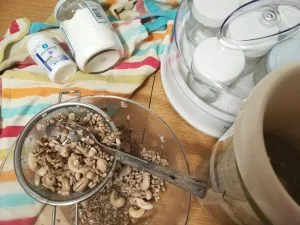 2.- The starter: You can use either a little soy yogurt or probiotic powder to culture the concentrated plant milk.
2.- The starter: You can use either a little soy yogurt or probiotic powder to culture the concentrated plant milk.
When buying soy yogurt make sure that it is not pasteurized and that the expiration date is as far as possible so that the bacteria offer us all their fermenting power and thus obtain better results.
Using probiotic capsules is the other option. There are many different brands and compositions. Be careful when choosing, the probiotic must have the Acidophilus strain in its bacterial composition and must not have lactose. Probiotics are more expensive than yogurt, but they serve not only to ferment vegan yogurts, but also to make vegan cheeses. But we will talk about cheeses in another article.
3.- The quantities: We start from the basis that each jar of yogurt is 200ml. To make vegan yogurt with soy milk, just put a tablespoon of soy yogurt or a probiotic sachet per 200ml jar. Soy yogurt is the easiest thing to do.
But be careful, to curdle coconut milk or almond milk or any other plant milk, the process is somewhat more complex. If we use the measures that we have used to curdle the soy milk, the result will be a semi-curdled yogurt, rather liquid. To get creamy and thick vegan yogurts made of coconut, almonds, cashews, pipes, walnuts, etc., the trick is to put much more yogurt or probiotic powder in each yogurt-maker jar, about 4-5 spoonfuls. Put 4 heaping tablespoons of soy yogurt or 4 probiotic capsules per jar.
Observe the photo with the results obtained based on the amount of soy yogurt that has been put to curdle the pipe milk in this case:
A) 1 tablespoon B) 2 tablespoons C) 3 tablespoons D) 4 tablespoons.
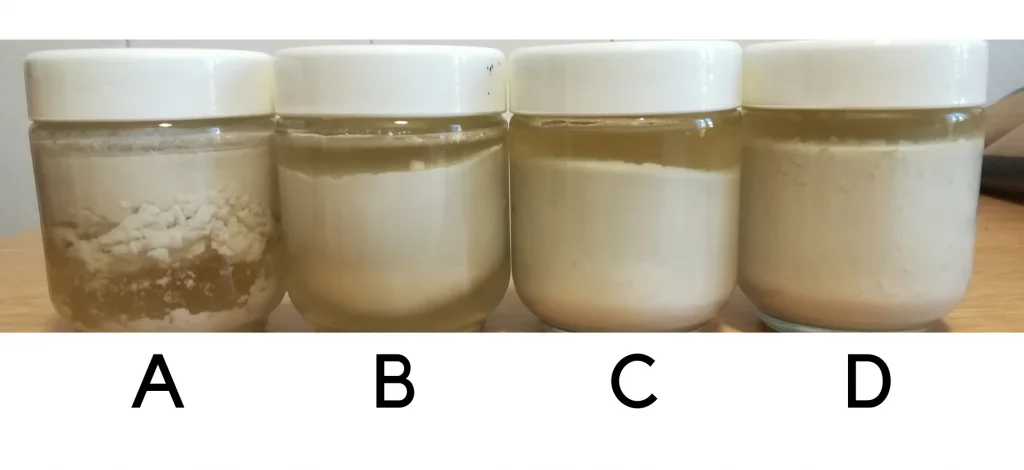
As you can see, to get creamy and thick vegan yogurts it is necessary to put much more yoghurt than is usually used to make yoghurts with animal milk or soy milk (1 tablespoon per jar). As you can see in all of them, a small well of serum appears to a greater or lesser extent. If what we are looking for is a creamy and rather solid texture, which allows you to eat the yogurt by the spoonful, then it is convenient to remove the serum from the bottom of the jar by tilting it. You can collect this serum in a glass to be able to make use of it; drink it directly to take advantage of its probiotic character and / or mix it with some juice or fruit.
From an economic and organoleptic point of view (taste and texture) it is much better to ferment plant milks with soy yogurt than to use probiotic powder.
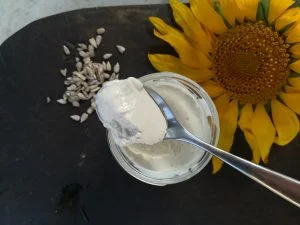
Creamy sunflower seed vegan yogurt
4.- The corn starch trick: I learned in a course specialized in vegan yogurts and cheeses that I made with Venu Sanz the option of using cornstarch to fatten plant milk and thus achieve creamier textures without having to quadruple the amounts of probiotics per jar. It is about putting two tablespoons of cornstarch per liter of milk. In this way, the milk thickens and the resulting yogurt will be much creamier. You have the instructions in the model recipe below.
5.- The temperature: It is convenient that the soy yogurt that we will use as a starter is at room temperature and the concentrated plant milk at 37ºC -more or less- when mixing them in the yogurt maker. Avoid using cold yogurt just out of the fridge. In the recipe that you have at the end of the article you will find the precise instructions.
6.- The fermentation and conservation time: 12 hours in a yogurt maker are enough to ferment the yogurts. If in this time the yoghurt has not set well, it will be in vain to prolong the fermentation time since it does not obtain a better result and we run the risk of losing the yogurt due to excess fermentation.
Turn off the yogurt maker and once the yogurts are cool, we can consume them. If they have not set well, they can be taken as liquid yogurt, shaking it well to mix the solid part with the liquid. On the nutritional side, there is no problem, and its consumption is healthy for the next three days.
If it has set well, they will last 4 days in the fridge, and we can eat them with a spoon.
It was so exciting to me to be finally able to make my own vegan probiotic yogurt at home, I almost cried of happiness and enjoyed every little bit!
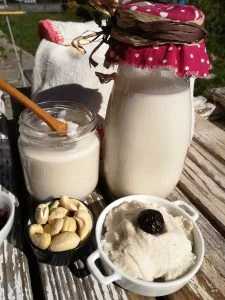 If we apply all the ideas of using the pulp that I have mentioned (the second extraction and cooking with the pulp), I am more satisfied, since with a liter of concentrated milk and a soy yogurt I get:
If we apply all the ideas of using the pulp that I have mentioned (the second extraction and cooking with the pulp), I am more satisfied, since with a liter of concentrated milk and a soy yogurt I get:
• 5 vegan delicous cultured yogurts of 200ml.
• 1 liter of plant milk (2nd extraction).
• Between 250-300 grams of pulp ideal to integrate it into a healthy recipe; cookies, cakes, vegan patées, pasta … You have some ideas in the pulp section of this blog.
Perfect! This already convinces me more.
Can you make vegan yogurt with oat milk? What seeds are the most suitable?
Milks made from grains won’t work here, as they’re not rich enough in protein and fats to ferment well. The best seeds and nuts to make homemade yogurt are:
- white or yellow soya beans
- fatty nuts (cashews, macadamia nuts, walnuts, coconut)
- sunflower seeds (due to their high protein and fat content)
Once you know the basics, we are going to see the details of the preparation.
VEGAN YOGURTS WITH PLANT MILK RECIPE:
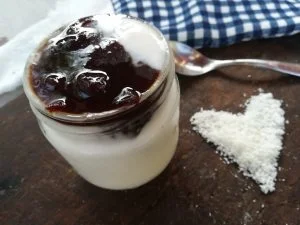
Creamy coconut yogurt with marmalade
Here’s the recipe, let’s give it a go! These amounts use half a litre of plant milk only, so you can start experimenting without being wasteful.
Step 1: how to make the concentrated plant milk
Ingredients:
- 150 g of seeds (almonds, pipes, walnuts …) or dehydrated grated coconut
- 1 litre of hot water (60ºC)
- 1 tablespoon of cornstarch.
- A pinch of salt
Instructions:
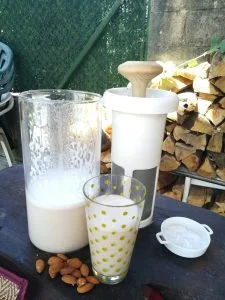 Soak the seeds for 3 hours and discard the soaking water. (In the case of white soybeans, we will soak 8 hours).
Soak the seeds for 3 hours and discard the soaking water. (In the case of white soybeans, we will soak 8 hours).- Fill the Vegan Milker jar with hot water and place the seeds/nuts in the filtering mesh. Now, use your blender to make the milk using the method detailed to make nut milk with Vegan Milker by ChufaMix, which most of you are already familiar with.
- As we need to use a high volume of seeds/nuts, we have to divide them into two parts and blend twice so it’s easier. First, we will beat 80 grams (almonds, walnuts, cashews, pipes …) and once they are beaten, we add another 80 grams and we beat again. If you’re using coconut, this volume will be even higher, so you also need to divide the amount into two 60 grams turns, removing the first one before blending the second.
- Filter the milk well and transfer it to a saucepan to heat it to 37ºC. If we are going to apply the starch trick, reserve a finger of milk in a glass and mix it with 1 tablespoon of starch until it is well diluted. Add it to the milk that rests in the casserole. Heat the milk over low heat until it starts to boil, stirring slowly from time to time so that it does not stick. When it starts to boil, lower the heat to a minimum and continue cooking for 5-7 minutes, stirring occasionally until the milk thickens.
Step 2: yogurt fermentation in the yogurt maker
Ingredients:
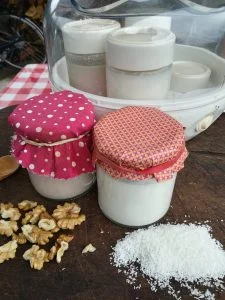 ½ litre of concentrated milk made in step 1: coconut milk, nut milk, pipe milk … any of them.
½ litre of concentrated milk made in step 1: coconut milk, nut milk, pipe milk … any of them.- 1 tablespoon of soy yogurt or 1 probiotic capsule.
Instructions:
- Wait until the starchy milk is tempered and when it is at 37ºC, more or less (if I can put my finger in without burning), it is time to add the yogurt or, failing that, the probiotic capsules and mix well.
- Pour the mixture into the jars, cover them and let them chill in the yogurt maker for 12 hours in the yogurt maker.
If you do not have corn starch, put 4-5 tablespoons of soy yogurt in each jar (equivalent to ½ jar) and pour the warm milk at 37ºC in them. Then mix well with a spoon until the mixture is homogenized. - After 12 hours, turn off the yogurt maker and let the jars cool.
- Once cold, chill in the fridge.
You’ll see how creamy the yogurt looks after a couple of hours, but if you want it to be even creamier, you can remove the “whey” (not actual whey since it’s vegan) liquid-y part. You can collect this serum in a glass to be able to make use of it; drink it directly to take advantage of its probiotic character and / or mix it with some juice or fruit. It’s really healthy too!
The yogurt that remains in the jar will be beaten well with a spoon and left to rest in the fridge. The next day we will find a 100% plant and well fermented yogurt, but with a creamy spoon texture. A real delicacy! Can you imagine how exquisite a nut flavored yogurt or sunflowers seeds can be?
Tips and tricks
- The vegan yogurt with sunflower seeds and walnuts achieve the texture of a conventional yogurt with this method. Vegan coconut and cashew yogurt, although it is very creamy, does not solidify as much, however, its flavor is exquisite.
- You can make the yogurt even thicker by blending a banana with it. This should be done once the yogurts have rested for at least one day in the fridge.
Well, you see that thanks to your questions we have discovered how to make coconut yogurt, nuts, pipes … Amazing! Thank you so much for asking. We keep learning.

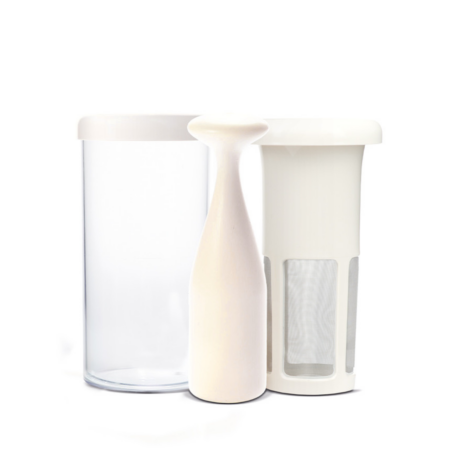
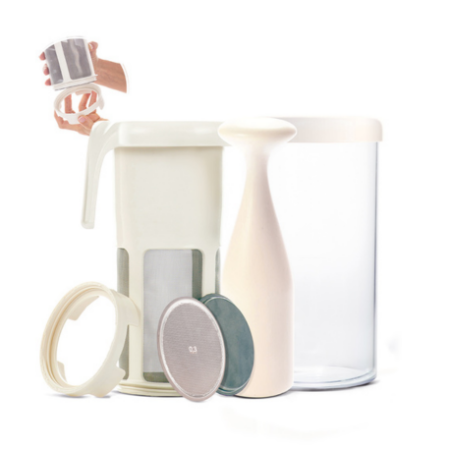
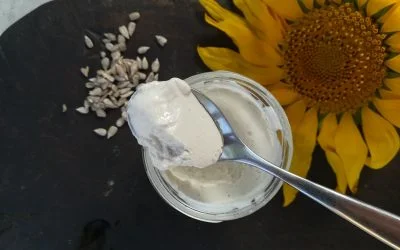
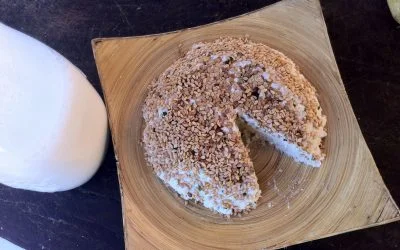
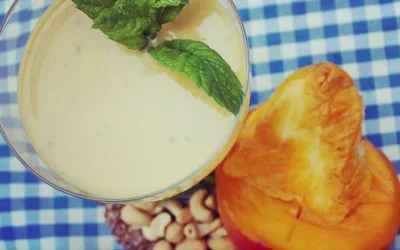
Hi,
thanks for the recipe.
Is it possible to use the home-made yogurt to make home-made yogurt again or do I always have to put fresh soya yogurt?
Bye,
Hella
Yes you can use spoonfuls of your homemade yogurt to make new batches.
This is so confusing – at one point you say to use 250-300g of soy beans to 1 litre of water, then later it’s 125g of beans. And then you’re mentioning 1/2 litre of concentrated milk.
And is the 400ml of yoghurt really for just 1/2 litre of concentrated milk, or for 1 litre of milk? Neither of those add up to the “5 vegan yogurts of 100ml” that are mentioned at the beginning.
Vegan is a intresring way to live and more and more people look for it
i had tryd by myself sime vegan milk receipts which was greart
i was really surprosed aboiut it
there are so many ways of intresting preparations. you can see also under https://bit.ly/2PR7AB4
thats how i made
Thank Joerg for your proposal, I will check it!
Assuming I use 4 probiotic capsules to make a liter of soya yoghurt in a yoghurt maker and subsequent 1 litre batches I use half a cup of soya yoghurt after how many batches if each batch I make a litre of soya yoghurt will my yoghurt become watery and then I have to reuse 4 probiotic capsules again roughly from your experience 😉 ??
Hi , interesting question but sorry to tell you I don’t have the answer. I haven’t gotten as many attempts to know at what rate the quality of the fermenting bacteria deteriorates.
I have done the tests with the yogurt maker I borrowed and once I managed to figure out the fermentation process I moved on to experiment with something else :). I’m sorry I can’t help you, but I’d really appreciate it if you can give us more information from your experience. Thanks
Hi which uohhutt maker is best for plant based milks?
Thank you
Hi Astrid , for me the best option is the Vegan Milker but here is an extensive article about different options. https://www.veganmilker.com/en/comparison-of-tools-used-to-make-plant-milks/
Hi, I have been searching for an English version of making yoghurts in my moulenix yoghurt maker. It is round, electric and has 6 or 7 jars in it, not the bigger ones you use. I have tried using the Alpro vegan yoghurt with a litre of soya, but it was not solid at the end of 12 hours. I will have to look for probiotic capsules I suppose, hopefully in a chemist. They tasted fine and I drunk them. But I would like a nice firm yoghurt. Could my problem been because I used a blackcurrant Vegan yoghurt.
Regards Chris, Gran Canaria.
Thanks for your feedback Chris! I apreciate a lot becaouse I learn much more with your comments.
Did you have a good result with the Alpro yogurth?
I try with it once and it didn’t work well for me, I neither like it taste… but it depends of each one taste, of course!